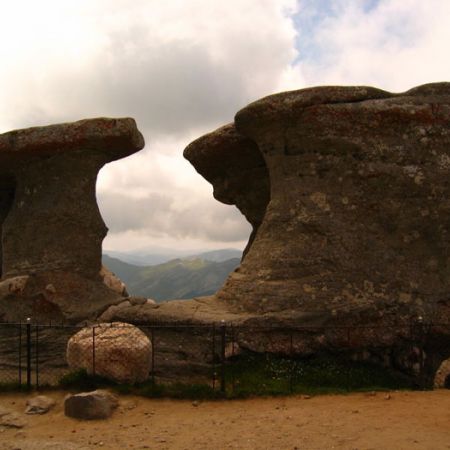Bucegi Mountains. Romania.

Up to the end 19th century the Bucegi mountains lived in peace and isolation their idilic, modest massive existence the Meridional Carpathis mountain chain.
Although storages with bronze objects were discovered in Sinaia and Predeal, which certified human presence in the area even from the bronze era (1800-1000 b.c.), up to until 300 years before, the Superiour Prahova Valley remained: "a wild place, a wilderness, an endless of secular forests that had never met the man's axe, a shelter for wild beasts, a place of delight for bears, wild hogs, deers… the road that bent over the Prahova Valley was bad, steep, and filled with rocks and logs, obstacles that were hard to overcome; with a horse, you could barely climb up and down the narrow paths over the hills and valleys that welcomed the traveler who was forced to make his will before making this journey… for he was forced to overcome for at last three days, at every step, obstacles that were so hard, and dangers thar were so great".
With all of this, the presence of man in the Bucegi is lost in the mist of time, the first documents that certify this date only from the 15th centyry. Bucegi is starting to be populated mostly after the fall of Constantinopole, in 1453, by a growling number of hermits and isoleted monks. "All the caves were under the laps of holes, all the natural shelters, built by natures caprice… were places inherited by a lonely hermit that lived the way Gold allowed… Among this hermits, in the valley also lived… some sort of monks, so called chiliarch, that had a cell build in a very rudimentary manner."
All this monks gathered every Saturday evenings, at St. Nicholas hermitage on the Molomot mountain (today named Furnica - Ant). "for the loint prayer and they partied until Monday morning, when, each one of the took up the road of loneliness." This hermitage was built in the 16th century and restored in the early 17th century by Nicolae Groza of Breaza or Cornu, a former bandit that become a monk when has become an old man.
At about the same time dates the first hermitage from the entry to the Ialomitei cave of wich the following tradition is tied, having Mihnea Voda cel Rau (1508-1509) as main character: "Mihne Voda once while traveling to yhe heart of the Bucegi entered the cave from the Ialomitei cusp to consult a foamous witch that lived in the cave, and she, instead of telling his fortune and telling him of love, started to course him, so bad, that Voda was scare and starting running through the forest until he fainded down. Coming across Mihnea, some shepherds took him to the stable, where he came around. The Mihnea Voda walled in the cave entry a hermitage and sattled a few monks there, as gratitude that he had survived."
Besides these monks and since way too long ago, the valley and hights of the Bucegi were trailed since May to September by the sheeps herds belonging to the shepherds in the near by villages or to the highlenders from the Barsei Country, from Rasnov and Sacele, or from Bran.
At the beginning of the 18th century many bandits make their persence felt on the roads. "in most parts of the Sacui in Transilvania. These Sacui robbed not only travelers, but even hermitages and monasteries. The tefts in the Prafova Valley started to die out eben since 1825-1830, thanks to the armed guards of the Sinaia monastery, as well as the many thief catchers that roamed the woods."
The recollection of this hermits, shepherds and bandits was carried on by the noumerous place names and legends tied to their presence.
The first written record about the Bucegi dates back from July 1839 and it belongs to a Franch man, Jean Alexandre Vaillant, professor and principal at the St. Sava College in Bucharest.
Mihai Haret wrote in 1915 about Vaillant's journey in the Bucegi: "We confess that we have never read a book that carried us about moved us quite as much as Vaillant's story did a story that besides its qualities shines due to an amazing preciseness of the geographical names. He gives us expalnation for many things that we had never revealed; therefore his book has an undeniable value for the past of the Bucegi".
Book Excerpt: Bucegii between Kogainon and Sahashrara
author: Dan Anghelescu

































